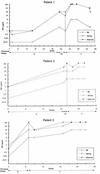Comparison of three methods for testing azole susceptibilities of Candida albicans strains isolated sequentially from oral cavities of AIDS patients
- PMID: 9620380
- PMCID: PMC104880
- DOI: 10.1128/JCM.36.6.1578-1583.1998
Comparison of three methods for testing azole susceptibilities of Candida albicans strains isolated sequentially from oral cavities of AIDS patients
Abstract
Three susceptibility testing procedures were compared to determine fluconazole, itraconazole, and ketoconazole MICs against 47 Candida albicans strains isolated sequentially from the oral cavities of five AIDS patients undergoing azole therapy. They included the broth microdilution method (BM), performed according to the National Committee for Clinical Laboratory Standards' tentative standard, the agar dilution method (AD), and the Etest; the latter two tests were performed both in Casitone agar (AD-Cas and Etest-Cas) and in RPMI (AD-RPMI and Etest-RPMI). Twenty-four- and 48-h MICs obtained by AD and Etest were compared with 48-h MICs obtained by BM. The MICs of all the azoles determined by BM were usually lower than those obtained by the other methods, mainly due to different reading criteria. In order to assess the most appropriate way of evaluating the agreement of MICs obtained by different methods with those produced by the proposed reference method (BM), we used the mean differences calculated according to Bland and Altman's method. Comparison of fluconazole MICs obtained by BM and AD-Cas yielded a mean difference of 3, and the percentages of agreement within +/-2 dilutions were 98 and 100% at 24 and 48 h, respectively. For ketoconazole and itraconazole MICs, lower mean differences were noted, and agreement ranged from 96 to 100%. Agreement between the AD-RPMI and BM results was poor for all azoles, and an increase in MICs was always observed between the 1st- and 2nd-day readings. Similarly, Etest-Cas gave better agreement with BM than did Etest-RPMI for all the azoles. BM, AD-Cas, and Etest-Cas each demonstrated a progressive increase in fluconazole MICs against strains isolated sequentially from a given patient, in accordance with the decreased clinical response to fluconazole.
Figures




References
-
- Barchiesi F, Colombo A L, McGough D A, Fothergill A W, Rinaldi M G. In vitro activity of itraconazole against fluconazole-susceptible and -resistant Candida albicans isolates from oral cavities of patients infected with human immunodeficiency virus. Antimicrob Agents Chemother. 1994;38:1530–1533. - PMC - PubMed
-
- Barchiesi F, Hollis R J, McGough D A, Scalise G, Rinaldi M G, Pfaller M A. DNA subtypes and fluconazole susceptibilities of Candida albicans from the oral cavities of patients with AIDS. Clin Infect Dis. 1995;20:634–640. - PubMed
-
- Bland J M, Altman D G. Statistical methods for assessing agreement between two methods of clinical measurement. Lancet. 1986;i:307–311. - PubMed
Publication types
MeSH terms
Substances
LinkOut - more resources
Full Text Sources
Medical

